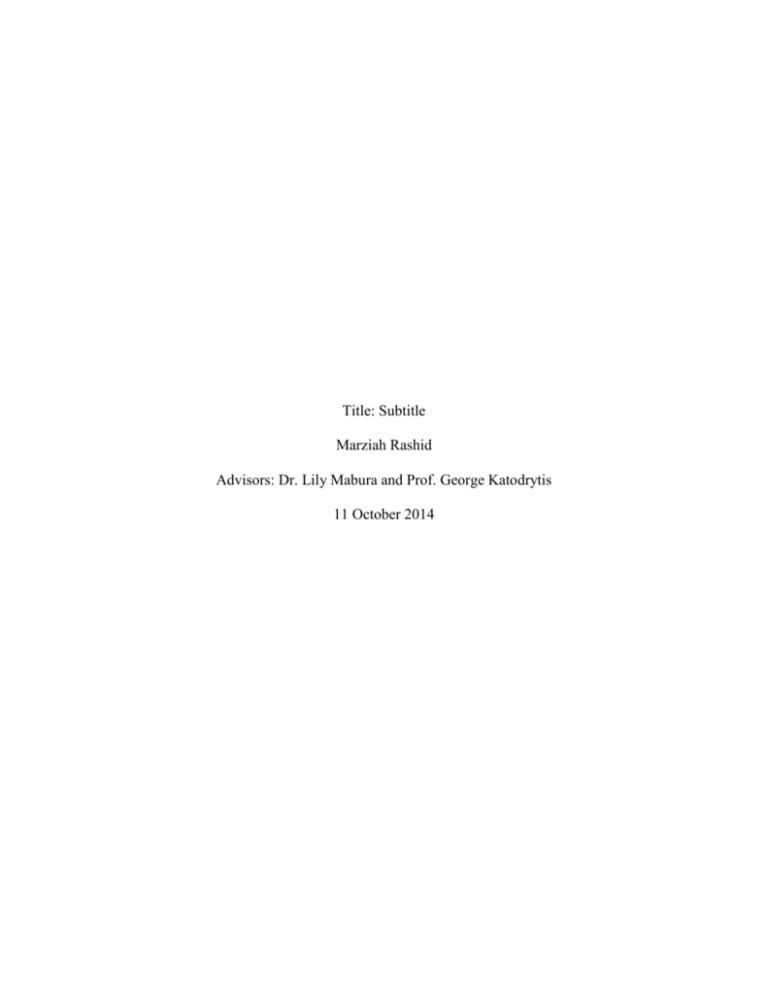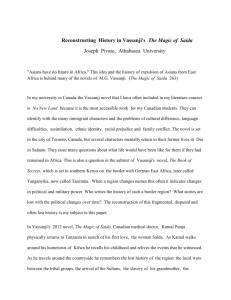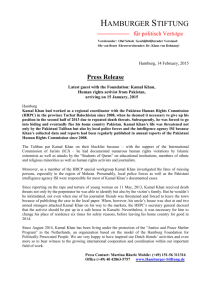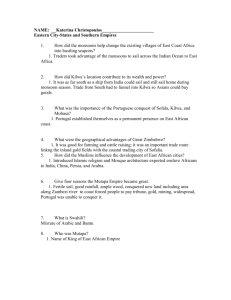Title 1 Title: Subtitle Marziah Rashid Advisors: Dr. Lily Mabura and
advertisement

Title: Subtitle Marziah Rashid Advisors: Dr. Lily Mabura and Prof. George Katodrytis 11 October 2014 Abstract Keywords: Title I. 1 Introduction Literary criticism holds the unfortunate reputation as one of the principal ivory tower disciplines in academia: elitist, self-interested, distant, and without practical use. However, this notion is complicated in light of the value of literary criticism in interdisciplinary research. This paper suggests that it is possible to extend literary criticism beyond the boundaries of literature in order to realize its veritable productivity. In particular, this paper examines the connections between the symbolic significance of the tree in M. G. Vassanji’s (2012) novel The Magic of Saida and the Larchfield Charity Organization’s Tanzania Orphanage Design Project. Vassanji (2012) is a prolific writer of both fiction and non-fiction who was born in Kenya, brought up in Tanzania, and resides in Canada. His novel The Magic of Saida (2012) is a work of diasporic literature that explores the protagonist Kamal Punja’s personal and public histories and recounts his return from Canada to his birthplace of Kilwa, Tanzania in search of his lost love Saida. On the other hand, the Tanzania Orphanage Design Project is the collaborative effort of the Tanzania-based Larchfield Charity Organization and a group of students and professionals in the UAE to develop the design of a home for disadvantaged children in Tanzania. II. Summary A. The Magic of Saida The Magic of Saida centers on Kamal Punja, a Tanzanian immigrant to Canada with Indian origins. The novel weaves together three main plot lines: Kamal’s interpretation of his personal heritage; an account of Kamal’s childhood in Tanzania and adolescence in Uganda; and a publisher’s retelling of Kamal’s search for Saida in Kilwa. This summary of the novel disentangles the three aforementioned threads and sets them in chronological order. Title 1 In the late nineteenth century, Kamal’s grandfather, Punja Devraj, becomes involved in a movement to overthrow the German colonizers in Kilwa and helps to recruit rebels including the poet Karim Abdelkarim, the brother of Saida’s grandfather Omari bin Tamim. Omari inadvertently betrays the rebels’ plot to a German captain and this culminates in the hanging of Punja and several other rebels, except Abdelkarim, who leaves Kilwa. Ten years later, Omari suspects that his brother is involved in the Maji Maji uprising and reluctantly betrays him to the Germans, whom he holds in admiration, and Abdelkarim is hanged. His execution and those of the first rebels takes place on a mango tree, which acquires the epithet of “the hangman’s tree” and bears “witness” to the history of Kilwa (pp. 109, 174). In the years that follow, Omari buries his brother’s poems in a case under the hangman’s tree, motivated by guilt when claims them as his own and receives praise for his poetic skill. The prologue of The Magic of Saida opens as a publisher, Martin Kigoma, encounters Kamal in a hospital in Dar es Salaam. Kamal tells Kigoma that he has recently abandoned his family and medical practice in Edmonton, Canada, and returned to his childhood home of Kilwa to seek his first love, Saida, whom he refers to as Kinjikitilé. Thus begins the story of Kamal’s life to the present, which is mediated through Kigoma’s narration. As a boy, Kamal lives alone with his Tanzanian mother, his Indian father having left them. Kamal and Saida develop a close friendship as he gives her weekly lessons and they frequent a lagoon in a cemetery together. Kamal listens to Mzee Omari’s recitals of his original poem The Composition of the Coming of the Modern Age, which recounts the Germans’ colonization of Tanzania and Tanzania’s resistance, in the town square. Shortly after a man in the audience mocks Mzee Omari for his past admiration of the Germans, Mzee Omari hangs himself from the hangman’s tree. Title 1 One day Kamal’s mother sends him to live with his Uncle Jaffu and Auntie Zera in Dar es Salaam to “become an Indian.” His cousins inform him that his mother sold him to his uncle. Kamal gradually assimilates into the Indian community in Dar. Before he leaves Dar to attend university in Kampala, Uganda, he travels to Kilwa. At the lagoon, he happens to meet Saida, who is now married, and the two make love. On the bus to Kampala, Kamal meets his to-be wife Shamim. When the leader of the new regime orders all Asians to leave Uganda, Kamal and Shamim relocate to Canada at her insistence, where they acquire jobs and raise a family. But with time the couple’s marriage deteriorates as Shamim draws closer to her Indian roots, and they separate. One day Kamal decides to fly to Kilwa to find Saida. Once there, he and his acquaintance Lateef track down Saida’s aunt Fatuma, who reveals that Saida has had a child and lives in an isolated village called Minazi Minne. At intervals during his mission, he reminisces about his past as he roams the city and once comes upon the mango tree that stands outside his old home. In Minazi Minne, Kamal is drugged and bound by a group of sorcerers who have been appointed by Saida’s husband to kill him in revenge for his affair with Saida. Lateef rescues him and takes him to the hospital. When he later returns to Minazi Minne with Kigoma, he is informed that one of his captors, Bibi Ramzani, has died. Kamal is struck when he discovers that Bibi Ramzani called herself Kinjikitilé: he found Saida after all. B. Tanzania Orphanage Design Project The Larchfield Project is an initiative of the Larchfield Charity Organization, a nongovernmental organization established in 2011, whose aim is to construct and run a home for Tanzanian street children whose parents have abandoned them or died – for example of HIV or in childbirth, both of which are common causes of premature death in Tanzania Title 1 (LarchfieldCharityOrganisation.com, 2014; TanzaniaInterdisciplinarySeminar.weebly.com, n.d.). The Project is coordinated by OpenSource_Architecture, a non-profit cooperative organization of architects, engineers, and designers. The site of the home will be Mkuranga, a rural area south of Dar es Salam where several such children can be found. The home will accommodate 50 and later 300 children between the ages of 6 months and 18 years and will serve as a model for more such homes to be built in the future in Africa (LarchfieldCharityOrganisation.com, 2014; Katodrytis, et al.). In its mission statement, Larchfield emphasizes that the home will provide the children with an environment that is homelike and that fosters in them a sense of responsibility to their community (LarchfieldCharityOrganisation.com, 2014). In early 2013, a group of professionals and students in the UAE, including students and faculty in the College of Architecture, Art, and Design at the American University of Sharjah, participated in the design of the children’s home. In a series of workshops, the group helped develop a proposal for the planning, landscape, architecture, and construction of the home, which was presented to an audience in March 2014 under the title “The Tanzania Orphanage Design Project.” The proposal includes housing for the children and their caretakers 1, accommodation for the administration staff and guests, a school, community spaces, and areas for services (Katodrytis, et al.). The proposed design for the home is such that it respects the surrounding area and the environment in that it does not compromise either. The construction of Larchfield is set to begin in early 2015 and the home is expected to be ready to open in mid-2015 (LarchfieldCharityOrganisation.com, 2014). III. 1 Thesis In the spirit of recreating an atmosphere that embodies home for the children, the caretakers are referred to as “Mamas” (TanzaniaInterdisciplinarySeminar.weebly.com, n.d.). Title 1 The Magic of Saida exhibits the theme of the native’s return to and effort to rediscover home; Larchfield lodges children who have been separated from their homes and in part attempts to recreate an atmosphere of home for them. In the novel, the hangman’s tree, the mango tree, and nature in general symbolize memories of and a sense of belonging to home for the protagonist. This symbolic meaning of trees and nature, which a literary analysis of the novel yields, can be applied in the design of Larchfield as a catalyst for innovation to reinforce and further the atmosphere of home there. In particular, one means to this end is to incorporate into the design of the home areas where the children plant trees or tend to their own respective plots of land. IV. Literature review V. Response A. The Tree as a Symbol for Home (i) The Magic of Saida The Magic of Saida thematizes the notion that in spite of the changes to the homeland that the emigrant observes upon his return, the land’s natural elements cause it to retain its sense of “home” for him. Therefore, nature serves as a symbol for home. Now, The Penguin Dictionary of Symbols (1996) notes that the various symbolic meanings of trees across cultures share one theme: “they all stem from the notion of the living cosmos in a state of perpetual regeneration” (Chevalier, et al., 1996, p. 1026). In the novel, Kamal’s memories of home are thus “regenerated” when he interacts with nature in Tanzania. For example, when Kamal returns to Tanzania from Edmonton, he chooses to travel on land from Dar to Kilwa presumably because the sight of nature on the way affirms that he is back home; in other words, “each bush, each blade of grass, each tree [is] so loaded with sentiment as to grip the heart of the returning native” Title 1 (Vassanji, 2012, p.8). Furthermore, on one of his rambles in Kilwa after he and Lateef visit Fatuma for the first time, he muses that Kilwa has lost its former identity and has become instead a “nothing place” (p. 65). Elsewhere in the novel, overwhelmed that he is back in Kilwa, he questions whether he is indeed home or “precisely nowhere” (p. 21). But amid this now alien place from which he feels isolated stands the mango tree, his one remaining link with home which acts as “a witness to his memories” of his time in Kilwa (p. 65). It is worth noting also that the continued presence of the tree is juxtaposed with the fact that his old house has been built over: one might expect that the loss of the house in which he grew up would sadden him, but in that moment he nonetheless experiences a sense of connection with Kilwa—and this is because he stands under the mango tree, an element of nature. Finally, Kamal’s metaphorical characterization throughout the novel as a “ghost” (p. 222,) contrasts with the diction employed in the novel’s description of the mango tree. While a ghost is a figure that exists between the states of life and death just as Kamal uncertainly drifts between identities, the tree is “ancient,” “old,” “gigantic,” “broad,” “staid,” and “dignified” (p. 33, 64), adjectives that denote rootedness and constancy; the word “staid” is of particular interest in this regard since it is etymologically the adjectival form of “stay” meaning “fixed, permanent” (Etymonline.com, n.d.) and is also acoustically similar to the past simple tense of the verb “to stay.” This contrast serves to emphasize the tree’s symbolization of home: the tree is the pillar of both times gone by and certainty to which Kamal, unsure of his identity, can tether himself. (ii) Tanzania Orphanage Design Project Needless to say, the children who have been brought to Larchfield have parted from their various homes in Tanzania; doubtless, many of them experience homesickness despite their improved circumstances at Larchfield. The tree’s symbolic representation of home in The Magic Title 1 of Saida can inspire a potential solution to this situation. For instance, with reference to the layout of the home below, one of the green spaces between the children’s dormitories on each side of the center axis can be repurposed as a small community garden, where the children each tend to their own plots of land in which they plant vegetation and flowers that grew near the homes they left. The proposed location of the gardens is strategic since they would be a part of the accommodation wing of the children’s home, where the children would likely spend their private hours. The gardens will form a literal manifestation of the atmosphere of home that Larchfield seeks to establish as noted in section II-B above. In addition, trees planted by the children in the areas designated as “Garden” and “Open Green Space” and along the sides of the center axis can have a similar effect in the long term for future tenants of the home. Of course, caution must be taken to plant trees that are indigenous to the Pwani region of Tanzania, where the Mkuranga district is located. This is because, as Maathai (2010) notes, trees that flourish in foreign climates can be detrimental to the local ecosystem; she takes the example of the eucalyptus tree, which was once imported to Kenya from Australia and which desiccates the soil where it is planted in Kenya (pp. 131-132). Title 1 What further benefits does the planting of trees incur? According to Havnevik et al. (2010), trees play important roles in the lives of the poor and marginalized population of Tanzania, of which the children at Larchfield constitute a sample. Ninety-five per cent of the country’s energy supply is derived from forests in the form of wood used for fuel and charcoal. Forests provide 75% of construction materials. Seventy per cent of Tanzania uses forest resources to manufacture medicines (p. 160). Hines and Eckman (1993) note that Materials derived from trees are used to make “domestic items” – household tools, utensils, equipment Workshops can be built in the school area where students can take classes in crafting these domestic items. These items can be used within the children’s home. Also “souvenir” stores could be built in the public area where visitors can buy these items, Title 1 providing the children with disposable income and self-empowering them as Larchfield already aims to do. Importance of indigenous trees as listed in Hines and Eckman. Example of baobab. All this stemmed from the idea in the novel that nature is associated with home. B. The Tree as a Symbol for Belonging: Issues of Community and History VI. (i) The Magic of Saida (ii) Tanzania Orphanage Design Project Conclusion References






